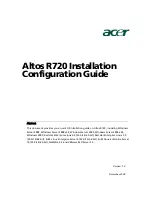
SuperServer 7088B-TR4FT User's Manual
60
Chapter 6
BIOS
6.1 Introduction
This chapter describes the AMI BIOS setup utility for the X10OBi Platform. It also provides
the instructions on how to navigate the AMI BIOS setup utility screens. The AMI ROM BIOS
is stored in a Flash EEPROM and can be easily updated.
BIOS Setup Utility
To enter the AMI BIOS setup utility screens, press the <Del> key while the system is booting
up.
Note:
In most cases, the <Del> key is used to invoke the AMI BIOS setup screen. There are
a few cases when other keys are used, such as <F3>, <F4>, etc.
Each main BIOS menu option is described in this manual. The Main BIOS setup menu screen
has two main frames. The left frame displays all the options that can be configured. Grayed-
out options cannot be configured. Options in blue can be configured by the user. The right
frame displays the key legend. Above the key legend is an area reserved for informational
text. When an option is selected in the left frame, it is highlighted in white. Often informational
text will accompany it.
Note:
The AMI BIOS has default informational messages built in. The manufacturer retains
the option to include, omit, or change any of these informational messages.
The AMI BIOS setup utility uses a key-based navigation system called "hot keys." Most of
the AMI BIOS setup utility "hot keys" can be used at any time during setup navigation. These
keys include <F3>, <F4>, <Enter>, <ESC>, arrow keys, etc.
Notes:
Options printed in Bold are default settings. <F3> is used to load optimal default
settings. <F4> is used to save the settings and exit the setup utility.
How To Change the Configuration Data
The configuration data that determines the system parameters may be changed by entering
the AMI BIOS setup utility. This setup utility can be accessed by pressing <Delete> at the
appropriate time during system boot.
Note:
For AMI UEFI BIOS Recovery, please refer to the UEFI BIOS Recovery User Guide
posted @ http://www.supermicro.com/support/manuals/.
















































